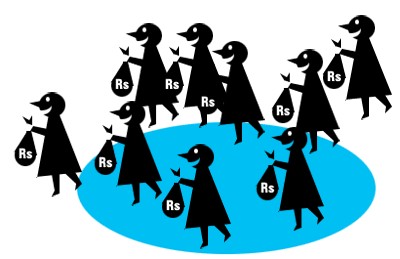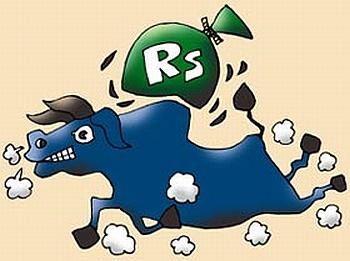Photographs: Illustration: Dominic Xavier/Rediff.com Amar Pandit
Most asset classes, whether equity, real estate or gold had a great going in 2010. However, a closer look will show that all these asset classes did go through ups and downs during the year.
Even as investors may get worried over periods of uncertainty, one can expect volatility to give ample opportunities to maximise profits in 2011.
The equity markets gave a 17 per cent return in an extremely choppy fashion. The index moved in the 18,000 and 16,000 band in the first seven months of the year.
The second half saw a clear uptrend that took the markets to the 21,000 level by Diwali. Even commodities made news last year.
Gold was stuck in a range of Rs 16,000-16,800 per 10 grams for an extended period till May 2010 and then moved in the Rs 17,000-18,500 per 10 grams range for the next few months.
...
Here are some opportunities to maximise profits in 2011
Photographs: Reuters
It is now in a range of Rs 20,000-20,700 per 10 grams and is expected to touch even higher levels.
Last year also saw interest rates on their way up. There were several interest rate increases by Reserve Bank of India (RBI) and subsequently, by banks on both the deposit and lending side.
Real estate prices too went up. But these did so without any genuine demand. Builders were able to raise easy money from the markets till October 2010 and along with their investors, were able to hold on to their inventories.
Real estate prices inched up despite the fact that November 2010 was one of the worst months for real estate. This month reported the least number of registrations by buyers.
...
Here are some opportunities to maximise profits in 2011
Photographs: Reuters
Let's look at the opportunities and risks associated with the various asset classes that investors will be looking at this year.
Equity: It was due to the foreign institutional investors (FIIs) interest in the Indian equity markets vis-a-vis the other emerging markets that Indian equity markets touched new highs. But these inflows turned tepid in the first few days of December.
Subsequently, the stock market ended the year at 20,500-levels despite expectations of it reaching the 21,000 mark. This can be blamed on factors such as inflation, rising oil prices, news of governments in Europe going bankrupt and the geo-political risks from North Korea.
Our local landscape has also been full of several scams, making people jittery on the impact these could have on the stock markets. The average Indian is not sure where the next one could spring from.
...
Here are some opportunities to maximise profits in 2011
Still, there are several positives, such as strong earnings growth and a rosy Gross Domestic Product (GDP) forecast, as reported by various agencies.
Though the start of 2011 could pose risks, there is a strong potential that 2011 as a year could surprise everyone on the upside. Nevertheless, it is suicidal, almost impossible, to really predict the volatile markets.
Investors would do well to do the following simple things with their portfolios:
Invest on every dip: Considering that we have broken the 50-day Moving Average, it is very likely that we are headed downwards.
There could be a bounce-back, which can be used to exit dud investments. Investors will do extremely well to invest 25 per cent at every five per cent dip.
One may even invest 10 per cent on every two-three per cent dip, as it's equally difficult to say when the markets would bottom out and reverse.
...
Here are some opportunities to maximise profits in 2011
Cut losses on bounce backs:
If you do not, the potential damage could be far higher. To be able to do that, you need to constantly evaluate your investments and remove funds and schemes that have not performed in the previous year.
Even a good investment can be down for several reasons, for an extended period of time. If the investment is still a good one, then you should buy more of it and average your costs.
Else, if you feel the fundamentals of the investments have deteriorated to an extent where there is no immediate potential, you can exit such investments.
...
Here are some opportunities to maximise profits in 2011
Book profits when nearing your goals:
Do not wait till the last moment. The Infosys results next week, the results season and then the upcoming budget would be potential triggers for the first few months.
The only thing is that you must act when the markets are correcting and not wait for the bottom, as there is no science to determine this accurately.
Gold: Global fears and shocks can keep gold at a high level. Actually, there is no precise way to do a price discovery process and know its intrinsic value.
Hence, the only thing one can depend on, is its price. Like other physical assets, this can be subjective and, hence, it's difficult to remain out of gold. One way to invest in gold is to do it in a staggered way as well.
Gold is now stuck in a range and one must look at investing on every dip in gold. Investors can even buy one gram every month through a Gold Exchange Traded Fund.
...
Here are some opportunities to maximise profits in 2011
Real Estate:
Prices have risen sharply, way beyond its previous high in 2008. This has made real estate, especially in cities like Mumbai, extremely unaffordable.
This is one asset class where you can see a huge bubble building. Affordability, which determines the fate of the real estate market, has gone for a toss and a slowing in home loan growth is visible.
Additionally, RBI has clamped on teaser loans and increased the margin funding which people need to pay up front.
All these factors, along with the liquidity of builders, will exert a downward pressure on real estate after April 2011.
...
Here are some opportunities to maximise profits in 2011
Photographs: Reuters
So wait until then before striking real estate deals or ensure there is a margin of safety (distress offering) in real estate deals. If you invested in real estate several years ago, this is the time to sell and make a killing.
Debt: Rising inflation continues to be a huge concern and it is quite likely RBI will raise cash reserve ratio (CRR).
CRR is the percentage of amount banks must keep with RBI.
While the rise sucked out excessive liquidity in the system, the money market and short-term yields spiked.
Even a liquid fund gave a return of 5.5-6 per cent. Fixed maturity Plans (FMPs) with a bank corporate (CD) portfolio were offering around 9-9.2 per cent yields on a 370-day portfolio.
...
Here are some opportunities to maximise profits in 2011
The best options in the debt fund space now are to look at FMPs and short-term income funds, which have an attractive yield to maturity.
In the highest tax brackets, the best avenue for short-term money is liquid plus and floating rate funds. When it comes to fixed deposits, do not lock yourself in long-term fixed rates as the rates could get better this year.
The key here is to look for better post-tax returns. Having realistic expectations will do a lot of long-term good for you.
The writer runs My Financial Advisor, a private wealth management firm.











article